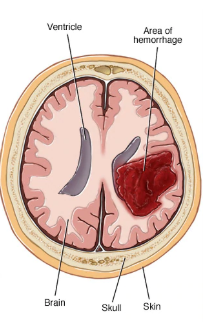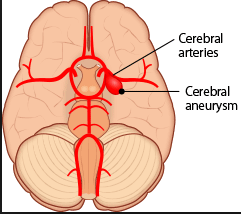Aetiology of Stroke
In medical terminology, aetiology is the study of the scientific causes of a disease. The main causes of stroke can be classified into three types which are Ischaemic stroke, Haemorrhagic stroke and Transient ischemic attack (TIA).
Ischaemic stroke

Ischaemic stroke or ischaemia occurs when there is a severely reduced blood flow caused by the blocking or narrowing of the arteries to the brain. Ischaemic stroke takes up about 80% of stroke cases and the most common of this stroke includes:
- Thrombotic stroke: When a blood clot (thrombus) forms in one of the arteries that supply blood to the brain. A clot may be caused by fatty deposits (plaque) that build up in arteries and cause reduced blood flow (atherosclerosis) or other artery conditions.
- Embolic stroke: When a blood clot or other debris forms away from the brain — commonly in your heart — and is swept through your bloodstream to lodge in narrower brain arteries. This type of blood clot is called an embolus.
Haemorrhagic stroke
Haemorrhagic stroke occurs when there is a leakage or rupture of a blood vessel in the brain. Brain haemorrhages can result from many conditions that affect your blood vessels, including:
- Uncontrolled high blood pressure (hypertension)
- Overtreatment with anticoagulants (blood thinners)
- Weak spots in your blood vessel walls (aneurysms)
Arteriovenous malformation is a less common cause of haemorrhage which is the rupture of an abnormal tangle of thin-walled blood vessels. The two types of haemorrhagic stroke are:

Intracerebral haemorrhage
- When a blood vessel in the brain bursts and spills into the surrounding brain tissue, resulting in brain cells damage. Brain cells beyond the leak are also damaged due to the deprivation of blood.
- Caused by high blood pressure, trauma, vascular malformations, use of blood-thinning medications and other conditions.

Subarachnoid haemorrhage
- When an artery on or near the surface of the brain bursts and spills into the space between the surface of the brain and skull and usually triggers a severe headache.
- A common cause of subarachnoid haemorrhage is the bursting of a small sack-shaped or berry-shaped aneurysm. Blood vessels in the brain may widen and narrow erratically (vasospasm) after the haemorrhage, causing brain cell damage due to the limiting of blood flow
Transient ischaemic attack (TIA)
Also known as a ministroke, a transient ischaemic attack (TIA) — is a temporary period of symptoms much the same as one experience in a stroke. TIAs may last for not more than minutes, caused by the temporary decrease in blood supply to part of the brain.
TIA happens when the blood flow is blocked by a clot or debris to part of the nervous system. Although there is no permanent tissue damage and lasting symptoms, having a TIA puts someone at greater risk of having a full-blown stroke, causing permanent damage later.
Source: https://www.mayoclinic.org/diseases-conditions/stroke/symptoms-causes/syc-20350113



